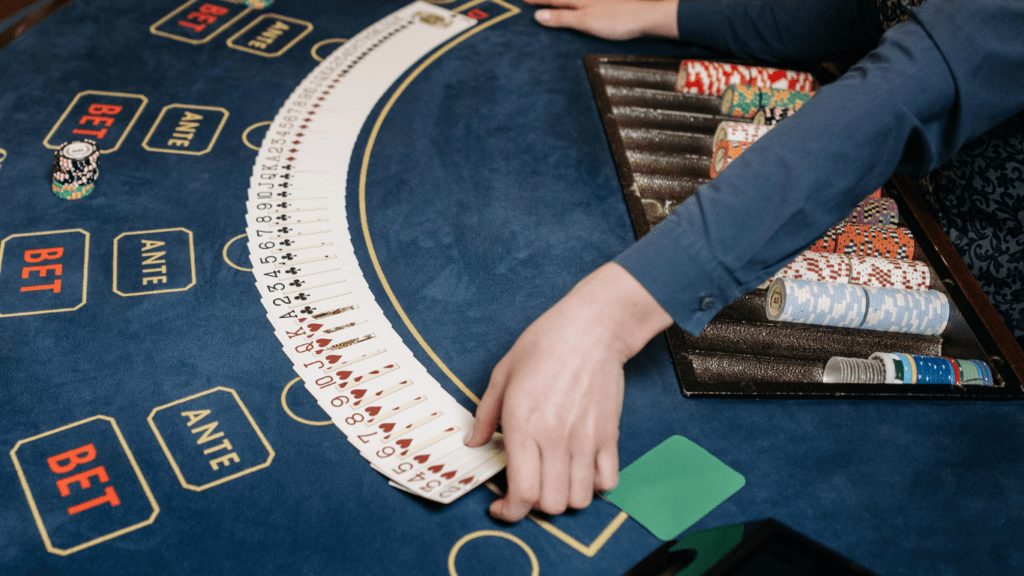Understanding the Basics of Casino Card Games
Grasping the fundamentals of casino card games lays the groundwork for successful gameplay. First and foremost, knowing game rules is crucial. Each card game, like Blackjack or Poker, has unique rules governing player actions and outcomes. Master these rules to make informed decisions during gameplay.
Identifying the odds is equally important. Casino card games have specific odds that dictate probabilities of winning. Understanding these odds, for example, the chances of being dealt a natural Blackjack, helps in making strategic choices.
Recognizing table etiquette enhances the gaming experience and often prevents costly errors. Players need to be mindful of actions like betting out of turn or handling cards improperly; casinos have strict policies on conduct.
Observing betting structures adds depth to your strategy. Different games feature various betting structures such as fixed-limit or no-limit. Tailoring one’s approach based on this knowledge can enhance strategic betting.
Leaning into practice solidifies these basics. Frequent play, whether in a casino setting or through digital simulations, reinforces understanding and sharpens skills, making advanced tactics more effective when utilized.
Technique 1: Card Counting
Card counting remains one of the most renowned tactics for gaining an advantage in casino card games. By keeping track of dealt cards, I can predict the likelihood of advantageous or disadvantageous cards appearing.
How It Works
Card counting involves assigning values to cards as they’re dealt. Typically, I give low cards (2-6) a value of +1, mid-range cards (7-9) a value of 0, and high cards (10-Ace) a value of -1. I track the running count to estimate the high-to-low card ratio remaining in the deck. When the count is positive, the deck favors the player, increasing potential winnings.
Pros and Cons
Pros:
- Increased Odds: I have an edge over the house by knowing when to place higher bets.
- Skill-Based: It leverages skill rather than pure luck, making it a rewarding technique for those who practice diligently.
Cons:
- Complexity: Maintaining the count requires concentration and some mathematical ability.
- Casino Resistance: Casinos often implement countermeasures, such as shuffling more frequently, making counting less effective.
Card counting, though challenging, offers the potential to maximize winnings for those willing to master it.
Technique 2: Bluffing Your Opponents

Bluffing is a critical card game technique that can significantly enhance your chances of success. Mastering the art involves more than just deception; it requires understanding both your cards and your opponents.
Reading Opponents
Success in bluffing hinges on accurately reading opponents. Watching for physical cues or “tells” that may reveal confidence or hesitation serves as a foundation. Identifying changes in betting patterns that deviate from typical behavior suggests an opportunity to exploit their uncertainty. Observing these signals consistently allows me to adjust my strategy and determine the right moments to bluff effectively.
Timing Your Bluffs
Careful timing makes bluffs more convincing and less detectable. Choosing spots when opponents show weakness, such as checking or making small bets, enhances my chances. Bluffing from a late position, when I’ve seen others’ actions, provides valuable insights. It’s crucial to maintain discipline and only attempt bluffs when the risk aligns with the potential reward, ensuring that leveraging this technique contributes to maximizing my winnings responsibly.
Technique 3: Mastering Probability
Understanding probability in card games provides a significant edge. Knowing the odds of specific outcomes lets players make informed decisions and adjust strategies accordingly.
Calculating Odds
Knowing how to calculate odds is crucial for mastering probability. In blackjack, players determine the likelihood of drawing a card that helps achieve 21. For example, if a player holds a hand totaling 16 and needs a 5 to reach 21, calculating the number of remaining 5s in the deck versus the total number of unknown cards is key. By assessing probabilities, players choose to hit or stand based on statistical advantage rather than instinct.
Game-Specific Strategies
- Each card game features unique probabilities that affect strategy.
- In Texas Hold’em, players assess their chances of forming a straight or flush by counting both their outs and cards that could complete their hand.
- Understanding pot odds helps in deciding whether to call a bet.
- For baccarat, when betting on the banker, knowing that the banker has a slightly higher winning probability than the player aids in informed wager placement.
- Analyzing specific game scenarios optimizes decision-making, leading to more successful outcomes.
By mastering probability, I’ve consistently improved my success across various casino card games.
Technique 4: Bankroll Management
Effective bankroll management is essential for maximizing winnings in casino card games. It ensures that I can continue playing without risking more than what I can afford.
Setting a Budget
Establishing a budget before entering the casino is crucial. I determine how much money I’m willing to play with, considering it as an entertainment expense. This approach prevents financial strain and adds enjoyment to the experience. To decide on a budget, I factor in other commitments and financial goals to ensure that the amount set aside remains within my means.
Sticking to Your Limits
Maintaining discipline is key in sticking to my limits. Once my budget is set, I resist the urge to exceed it, regardless of winning or losing streaks. Employing a stop-loss strategy helps me walk away when losses reach a pre-determined amount, preserving my bankroll. Similarly, setting a stop-win limit ensures that I don’t lose all my winnings by reinvesting them recklessly. These strategies allow me to enjoy card games while managing my finances effectively.
Technique 5: Table Selection
Choosing the right table is crucial for maximizing your winnings at casino card games. Through careful selection, I’ve found tables that align with my playing style and goals.
Identifying Favorable Tables
When identifying favorable tables, I consider factors like table limits and dealer tendencies. Lower limits allow for longer play without risking too much, which favors strategies involving gradual betting increases. Observing dealer reveals key insights; dealers sticking consistently to established routines may offer more predictable gameplay scenarios. I also look for tables where players seem relaxed, as high tension often indicates more strategic, potentially challenging opposition.
Assessing Player Competition
Assessing player competition involves gauging opponents’ skills and tendencies. I observe betting patterns and reactions to cards, which reveal their comfort level and potential strategies. Less experienced players often make larger, emotional bets, creating opportunities to capitalize on predictable actions. However, if competitive, skilled players dominate the table, I rethink my position, considering relocation to a less challenging setting. Selecting the right mix of opponents enhances my chances of strategic success.



 Lead Content Strategist
Willie Maxson is the Lead Content Strategist at Dice Gamblers Deal, where he leverages his extensive knowledge of gambling and content creation to produce educational and engaging material for players at all skill levels. Willie’s background in journalism, combined with a deep understanding of casino games, allows him to break down complex gambling strategies into clear, digestible content that helps readers master the art of winning at the tables. From detailed blackjack strategies to the best slot machine tips, Willie creates resources that provide valuable insights into the world of gambling. His approach is centered around making learning fun and accessible, with content that’s as enjoyable as it is informative. He works closely with the team to ensure that every article, guide, and update on the website is of the highest quality, empowering players to make more informed decisions and ultimately increase their winnings.
Lead Content Strategist
Willie Maxson is the Lead Content Strategist at Dice Gamblers Deal, where he leverages his extensive knowledge of gambling and content creation to produce educational and engaging material for players at all skill levels. Willie’s background in journalism, combined with a deep understanding of casino games, allows him to break down complex gambling strategies into clear, digestible content that helps readers master the art of winning at the tables. From detailed blackjack strategies to the best slot machine tips, Willie creates resources that provide valuable insights into the world of gambling. His approach is centered around making learning fun and accessible, with content that’s as enjoyable as it is informative. He works closely with the team to ensure that every article, guide, and update on the website is of the highest quality, empowering players to make more informed decisions and ultimately increase their winnings.
